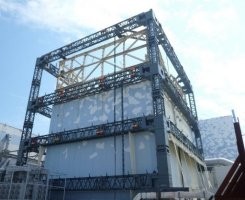Fukushima City Begins
Decontamination Of Homes

Fukushima Power Plant
EMF Protection Devices
Magnetic Field Detector
10/18/2011 |
By Agence France-Presse
Fukushima City began Tuesday its first decontamination of
private properties, seven months after the worst atomic
accident since Chernobyl spread radioactive materials over
eastern Japan.
Fukushima City began Tuesday its first decontamination of
private properties, seven months after the worst atomic
accident since Chernobyl spread radioactive materials over
eastern Japan.
The first such organised cleanup of peoples' homes by an
affected municipality follows work by various communities in
northeast Japan to decontaminate public areas such as
schools, parks and daycare centres.
Prime Minister Yoshihiko Noda visited the city for the
second time since he took office less than two months ago,
with many residents voicing frustration over what they see
as a slow government response to the crisis.
Tuesday's clean up comes amid growing concerns that
potentially harmful contamination spread more widely than
thought amid discoveries of radiation hot spots in areas
such Chiba and in Tokyo more than 200 kilometres away.
Fukushima City is home to roughly 300,000 residents and sits
60 kilometres (35 miles) northwest of the Fukushima Daiichi
nuclear plant crippled in the March 11 earthquake and
tsunami, that left around 20,000 dead or missing.
Radiation emissions from the plant have since fallen as
workers race to bring its crippled reactors into a safe
state of cold shutdown by year-end, but Japan faces a huge
operation to decontaminate areas nearby.
Areas northwest of the plant were hit hardest by radiation
due to wind patterns at the peak of the crisis.
Tens of thousands remain evacuated from homes and businesses
in a 20 kilometre (12 mile) radius no-go zone around the
plant and some areas beyond.
In Fukushima City, authorities plan to clean around 110,000
houses as well as streets and public buildings.
On Tuesday work crews wearing face masks used high pressure
hoses to wash down houses in the Onami district, where
elevated levels of radiation contamination have been
detected.
They also cut trees in gardens and excavated top soil with
the aim of reducing radioactivity readings there to below
1.0 microsievert per hour.
Yoshiharu Suda, whose house was among the first to be
cleaned, said he wished the decontamination effort had been
made earlier.
"I think it might be too late," he told national broadcaster
NHK, standing in front of his house where radiation readings
double the government target were detected Monday.
The task of restoring towns and villages even in lightly
contaminated zones is complicated, with high costs and
logistical issues of where to store soil and sludge
contaminated with substances such as caesium after it is
removed.
The government has sought to calm public fears and overcome
mistrust of official radiation surveys, claiming that areas
away from the immediate vicinities of the wrecked plant
should be safe.
But concerned citizens armed with their own measuring tools
have been finding small localised "hot spots" with high
radiation levels.
In the Adachi ward in Tokyo, a drain in the back of a school
pool registered 3.99 microsieverts per hour of radiation
Monday night, prompting officials to decontaminate the area.
Based on the Japanese science ministry's criteria, that
level is equivalent to an annual dose of about 21
millisieverts -- above the 20 millisievert level that
mandates a public evacuation.
National Broadcaster NHK on Friday reported that a citizens'
group in Funabashi City in Chiba, east of Tokyo, detected
radiation levels of up to 5.82 microsieverts per hour at a
local park, compared to official readings of 1.55
microsieverts per hour at the site.
Variable winds, weather and topography result in an uneven
spread of contamination, experts say, and radioactive
elements tend to concentrate in places where dust and rain
water accumulate such as drains and ditches.
The accident has discouraged consumers from buying farm
produce from Fukushima and surrounding regions following
reported cases of contaminated water, beef, vegetables, tea
and seafood.
http://www.emfnews.org/store
|
|
"Revolutionary New Technologies
Protect You from the Harmful Effects of
Cell Phone Radiation,
Computers, Bluetooth Headsets, Microwave Ovens,
Cordless Phones, and other Wireless Technologies."
|